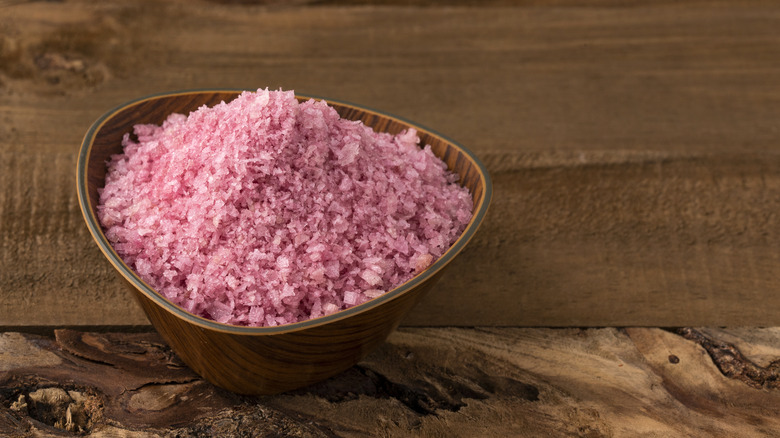The Unexpected Boozy Ingredient You Should Add To Salt
You'd be hard pressed to find a recipe that doesn't call for at least a pinch of salt — and for good reason. Salt is the powerhouse of the spice world, amplifying flavors in everything from savory dinners to sweet desserts. With more than 16 varieties of salt, each with its own flavor profile and purpose, why not go one step further and make your own blend using red wine?
That's right — that half-empty bottle of cab on the counter isn't just for sipping; it can actually transform plain salt into a rich, flavorful addition to your dinner. The process is simple: Mix equal parts salt and wine in a bowl and let sit for at least an hour, or overnight to get maximum flavor infusion. Then, strain the excess liquid with a fine mesh sieve or cheesecloth, resulting in salt with a wet sand texture and beautiful crimson color. Add other seasonings if you'd like — such as black pepper and dried herbs — and spread it on a baking sheet to dry in the oven at 125 degrees Fahrenheit (or whatever your oven's lowest setting is). Alternatively, allow the mixture to air dry (although this will take much longer). Store in an airtight jar and sprinkle whenever you want a subtle hit of savory, wine-kissed flavor.
How to use (and show off) your red wine salt
Once your wine salt is dry and ready, the fun begins. Think of it as a finishing salt rather than a cooking salt, as it shines when sprinkled right before serving. Dust it over a classic Salisbury steak with mushroom gravy, roasted vegetables, or even a slice of dark chocolate cake for a sweet-salty punch. It also makes a killer cocktail rim: Swap plain salt for wine salt on your next margarita or Bloody Mary for instant flair.
When it comes to presentation, make sure to show off the purple hue in a clear glass jar or small tin. Add a simple label, and you've got a homemade foodie gift that feels far more gourmet than it is complicated. For an extra touch, layer it with other flavored salts like citrus zest salt or chili salt for a DIY "salt sampler" that looks as good as it tastes.
As for choosing your ingredients, opt for a coarse, flaky salt like kosher salt or sea salt. Their texture holds the wine flavor better than standard table salt. For wine, bold reds like cabernet sauvignon, syrah, or zinfandel lend the richest flavor and deepest color, but you can also play around. Rosé makes for a lighter, pink-tinged salt, while a crisp white like sauvignon blanc creates a subtle, herbal-tasting version.


